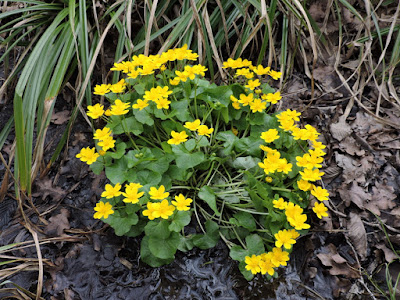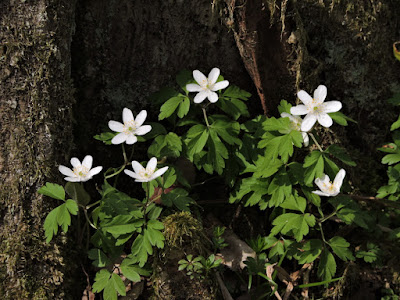 |
| Fritillaria meleagris (Snake's head fritillary), Krakovski gozd, 25th March 2016. A beautiful flower of wet meadows and alluvial forest that has become rare and threatened by the drainage of wetlands. Krakovski gozd, together with Ljubljansko barje (Ljubljana marsh) is one of the Slovene strongholds of this species. |
 |
| Black Stork Ciconia nigra, Krakovski gozd, 25th March 2016. This bird was resting and preening in the middle of the main forest road through Krakovo forest. The area supports 2 to 4 breeding pairs of this rare species. |
 |
| Pulmonaria dacica, Krakovski gozd, 25 March 2016. Very common flower in the Krakovo forest - a specialty of the area. In Slovenia inhabiting only alluvial forests of Quercus robur such as Krakovski gozd and a few others. |
 |
| Gagea spathacea, Krakovski gozd, 25 March 2016. Another specialty of the area, inhabiting alluvial forests and wet woodlands. |
 |
| Caltha palustris, Krakovski gozd, 25 March 2016. A common species in water ditches throughout the forest. |
 |
| Lowland alluvial forest of English oak Quercus robur and European hornbeam Carpinus betulus (Pseudostellario-Quercetum & Pseudostellario-Carpinetum), Krakovski gozd, 25 March 2016. A large amount of dead and decaying trees is present in the forest, thus supporting a thriving population of woodpeckers and other cavity-nesting birds. |
 |
| Middle Spotted Woodpecker Dendrocopos medius, Krakovski gozd, 25 March 2016. One of the largest breeding populations in Slovenia is found in the Krakovo forest. I had up to 6-7 individuals. Nearby the above bird was also a Ural Owl Strix uralensis! |
 |
| Alluvial forest with English oak Quercus robur, Krakovski gozd, 25 March 2016. |
 |
| Ranunculus ficaria, Krakovski gozd, 25 March 2016. |
 |
| Pulmonaria dacica & Anemone nemorosa, Krakovski gozd, 25 March 2016. These species create vast white & blue carpets all over the forest's floor. |
 |
| Ranunculus auricomus, Krakovski gozd, 25 March 2016. Another very common flower in the Krakovo forest, loving wet forest and water margins. |
 |
| Veratrum album & Anemone nemorosa, Krakovski gozd, 25 March 2016. |
 |
| Chrysosplenium alternifolium (with Pulmonaria dacica), Krakovski gozd, 25 March 2016. |
 |
| Anemone nemorosa, Krakovski gozd, 25 March 2016. |
 |
| Green sprouts of Iris pseudacorus, with Caltha palustris (in the back), Krakovski gozd, 25 March 2016. The forest is full of flowering Irises later in the season - see this post. |
 |
| Oxalis acetosella, Krakovski gozd, 25 March 2016. |
 |
| Leucojum vernum, Krakovski gozd, 25 March 2016. |
 |
| Alluvial forest with Caltha palustris, Krakovski gozd, 25 March 2016. |
 |
| White Stork Ciconia ciconia, Dobrava pri Škocjanu (Krakovski gozd area), 25th March 2016. The first storks of the year! |
On Friday I visited the fabulous Krakovski gozd (Krakovo forest), east of Novo Mesto in south-eastern Slovenia. Krakovski gozd is the largest area of uninterrupted lowland alluvial forest in Slovenia. It has a special conservation value due to the rarity of this kind of habitat in Slovenia.
The most important bird species are Middle Spotted Woodpecker Dendrocopos medius, Collared Flycatcher Ficedula albicollis, Black Stork Ciconia nigra, White-tailed Eagle Haliaeetus albicilla, Ural Owl Strix uralensis and Lesser Grey Shrike Lanius minor (in the nearby farmlands). The first two species have very high breeding densities in the forest, thus they are quite easy to observe.
On the botanical front, the most characteristic (and rare on a national level) plants include: Fritillaria meleagris, Pulmonaria dacica, Gagea spathacea, Viola uliginosa, Epipactis nordeniorum.
